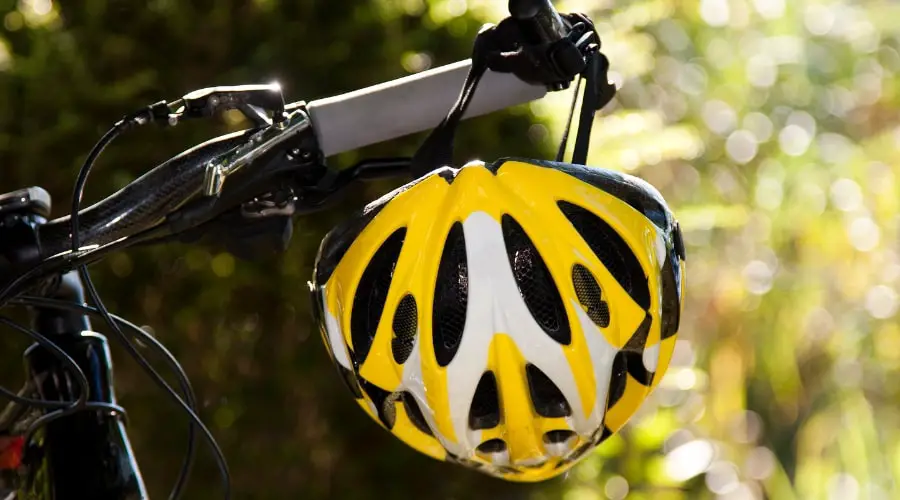Bicycle helmets are an essential safety gear for anyone who rides a bike. Whether you use a bike for commuting, recreation, or sport, wearing a helmet is one of the best ways to protect yourself from head injuries in the event of an accident. With so many options available on the market, choosing the best bicycle helmet for your needs can be overwhelming.
In this article, we’ll guide you through the various factors to consider when choosing a bicycle helmet, including safety standards, construction materials, fit and comfort, ventilation, visors and eye protection, reflectivity, and style and design.

Why Wear a Bicycle Helmet?
Protecting Your Head from Injuries
The primary reason for wearing a bicycle helmet is to protect your head from injuries in the event of an accident. Head injuries can range from minor cuts and bruises to more severe concussions and even life-threatening brain injuries. Wearing a helmet can reduce the risk of these injuries and provide some level of protection.
Legal Requirements
In many states and countries, wearing a helmet while riding a bike is a legal requirement. Failing to wear a helmet can result in fines, and in some cases, legal action. Even if wearing a helmet isn’t required by law in your area, it’s still a good idea to wear one to protect your head and set a good example for others.
Setting an Example for Others
Wearing a bicycle helmet can set a positive example for others, especially children. When children see adults wearing helmets while riding bikes, they’re more likely to adopt this behavior themselves, which can help reduce the number of head injuries and fatalities resulting from bike accidents.
What Makes a Good Bicycle Helmet?
There are several factors to consider when choosing a bicycle helmet. Here are the most important ones:
Safety Standards
The most critical factor when choosing a bicycle helmet is its safety standards. Helmets should meet the safety standards set by organizations such as the Consumer Product Safety Commission (CPSC) in the United States or the European Committee for Standardization (CEN) in Europe. These organizations test helmets to ensure they provide adequate protection against impact forces and penetration, and they set minimum requirements for coverage and retention systems.
Construction Materials
The materials used to construct the helmet can also affect its safety and performance. Most bicycle helmets are made from polycarbonate, expanded polystyrene (EPS), or a combination of the two. Polycarbonate is a durable and lightweight material that can withstand impacts, while EPS is a foam-like material that can absorb shock and distribute it across the helmet. Some helmets also feature MIPS (Multi-directional Impact Protection System) technology, which can reduce rotational forces on the brain during an impact.
Fit and Comfort
A helmet that fits well and is comfortable to wear is more likely to be worn regularly. Helmets should fit snugly on your head without being too tight or too loose. They should also have padding and ventilation systems that provide adequate airflow and prevent overheating.
Ventilation
Adequate ventilation is essential for preventing overheating and providing comfort during long rides. Look for helmets with multiple vents that allow air to flow through the helmet, keeping your head cool and dry.
Reflectivity
Helmets with reflective materials or coatings can make you more visible to motorists and other cyclists, especially in low-light conditions. Look for helmets with reflective stickers, logos, or materials to increase your visibility and enhance your safety.

Style and Design
While safety should always be the top priority, style, and design are also essential considerations when choosing a bicycle helmet. Helmets come in a range of styles and colors to suit different tastes and preferences. You’re more likely to wear a helmet regularly if you like the way it looks and feels.
Types of Bicycle Helmets
There are several types of bicycle helmets to choose from, each designed for a specific type of riding. Here are the most common types:
Road Bike Helmets
Road bike helmets are designed for speed and aerodynamics. They’re lightweight, have fewer vents, and have a smooth, compact shape that reduces wind resistance. Road bike helmets are ideal for racing, time trials, and other high-speed riding.
Mountain Bike Helmets
Mountain bike helmets are designed for off-road riding and provide more coverage and protection than road bike helmets. They have larger visors, more ventilation, and extended coverage around the back and sides of the head. Mountain bike helmets are ideal for trail riding, downhill racing, and other off-road activities.
Commuter Helmets
Commuter helmets are designed for urban riding and provide a balance of protection, comfort, and style. They have more ventilation than mountain bike helmets and may have built-in lights or reflective materials for increased visibility. Commuter helmets are ideal for commuting to work, running errands, and other city riding.
Youth Helmets
Youth helmets are designed for children and teenagers and provide the same level of protection as adult helmets. They come in a range of styles and colors to suit different tastes and preferences and are available in sizes to fit different head sizes.
How to Choose the Right Size and Fit
Choosing the right size and fit is essential for ensuring your helmet provides adequate protection and comfort. Here are the steps to follow:
Measuring Your Head
To measure your head, wrap a tape measure around the widest part of your head, just above your eyebrows and ears. Record the measurement in centimeters or inches.
Trying on Helmets
Try on several helmets in your size and adjust the retention system to ensure a snug fit. The helmet should sit low on your forehead, cover the top of your head, and not shift or wobble when you move your head.
Adjusting the Fit
Most helmets come with a retention system that allows you to adjust the fit. The system should be snug but not too tight, and the chin strap should be adjusted to fit securely under your chin.
How to Maintain and Replace Your Helmet
Maintaining your helmet can help prolong its lifespan and ensure it provides adequate protection. Here are some tips:
Cleaning and Care
Clean your helmet regularly with mild soap and warm water, and avoid using harsh chemicals or abrasive materials. Allow the helmet to air dry and store it in a cool, dry place.
When to Replace Your Helmet
Replace your helmet if it’s been involved in a crash, if the foam is cracked or damaged, or if it’s more than five years old. Over time, the materials in the helmet can degrade, reducing its effectiveness.
Top Bicycle Helmets on the Market
Here are our top picks for the best bicycle helmets on the market:
Giro Register MIPS
The Giro Register MIPS is a lightweight and affordable helmet that features MIPS technology to reduce rotational forces on the brain. It has 22 vents for ample airflow and an easy-to-use adjustment system for a comfortable and secure fit.
Bell Falcon MIPS
The Bell Falcon MIPS is a versatile and comfortable helmet that’s ideal for road and gravel riding. It features MIPS technology, a lightweight design, and an adjustable visor for added versatility.
Specialized Echelon II MIPS
The Specialized Echelon II MIPS is a high-performance helmet that features a streamlined design and ample ventilation. It has a lightweight and durable construction and comes with MIPS technology for enhanced safety.
POC Omne Air SPIN
The POC Omne Air SPIN is a stylish and comfortable helmet that provides excellent ventilation and protection. It features POC’s SPIN technology, which helps reduce rotational forces on the brain and comes in a range of colors to suit different styles.

Smith Trace MIPS
The Smith Trace MIPS is a premium helmet that offers top-of-the-line protection and comfort. It features MIPS technology, a lightweight and durable construction, and excellent ventilation for all-day comfort.
FAQs:
Are expensive helmets better than cheaper ones?
Not necessarily. While some expensive helmets may have more features and higher-quality construction materials, they may not necessarily be safer than cheaper ones. It’s more important to choose a helmet that meets the necessary safety standards and fits well and comfortably.
Can I use a road bike helmet for mountain biking, and vice versa?
It’s not recommended to use a road bike helmet for mountain biking or vice versa. Each type of helmet is designed for different types of riding and provides different levels of protection and coverage.
Should I replace my helmet after a crash, even if it looks fine?
Yes. Even if your helmet looks fine after a crash, it may have sustained damage that’s not visible to the naked eye. The materials in the helmet can degrade over time, reducing its effectiveness.
Can I wear a helmet with a ponytail or braids?
Yes. Some helmets come with adjustable retention systems that can accommodate ponytails or braids.
How long do bicycle helmets last?
Most bicycle helmets have a lifespan of around five years, after which they should be replaced. However, if a helmet has been involved in a crash or sustained damage, it should be replaced immediately.
Conclusion
Choosing the right bicycle helmet is essential for your safety and comfort while riding your bike. When selecting a helmet, consider its safety standards, construction materials, fit and comfort, ventilation, visors and eye protection, reflectivity, and style and design. Always make sure to choose the right size and fit, and maintain and replace your helmet when needed. Our top picks for the best bicycle helmets on the market are the Giro Register MIPS, Bell Falcon MIPS, Specialized Echelon II MIPS, POC Omne Air SPIN, and Smith Trace MIPS.
Helmetslab is a website that focuses on providing in-depth reviews and information about different types of helmets, including motorcycle helmets and others helmets. I am writing a post with proper research on the info that helps helmet users.

